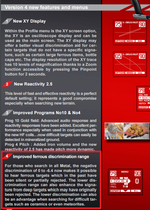OutdoorAdv
Bronze Member
- Apr 16, 2013
- 2,457
- 3,350
- 🥇 Banner finds
- 1
- Detector(s) used
- XP Deus,
GPX 4500,
Equinox 800,
AT Max
- Primary Interest:
- Metal Detecting
So I saw this when the fist v4 advert was released a few weeks ago. The advert says you can use negative disc to find ceramics! I thought this was a French->English translation issue. I figured what they meant was that negative disc would allow us to find even smaller iron, leading to trash pits, leading to ceramics... but not actually detect ceramics. I even texted a friend that has a Deus and laughed saying they need to proof read these things better. This goes against how I thought a metal detector worked... I thought you needed metal to detect! 
Here is the advert section that I boxed in red.

Yesterday I saw this updated v4 manual pamphlet and it actually shows an XY plot of what a ceramic target would look like... WHAT! So now I'm not thinking this is a translation issue, but that it can actually detect ceramics. I feel like a nut even believing this but perhaps its can detect the concentrated mineralization in the clay used to make ceramics??

If true, this would be huge for me. I spend a lot of time hunting for trash pits. Typically the only way to locate them is to look for extremely concentrated iron, or large deep iron. Being able to detect a concentration of ceramics would be huge. Its sounds crazy to even say... but now I've seen it in two spots. I still don't believe it and wouldn't believe it until I saw it, because it goes against how I thought a detector worked.
It even made me google a kind of pottery I find called Staffordshire "ironstone" because I thought perhaps there was iron in it... nope, no iron in ironstone. Its name is due to its durability.
Did anyone else notice this reference to ceramics? I haven't seen anyone else talking about it on and of the fb groups or other forums. Just wanted to see if everyone is as baffled as I am.
Here is the advert section that I boxed in red.

Yesterday I saw this updated v4 manual pamphlet and it actually shows an XY plot of what a ceramic target would look like... WHAT! So now I'm not thinking this is a translation issue, but that it can actually detect ceramics. I feel like a nut even believing this but perhaps its can detect the concentrated mineralization in the clay used to make ceramics??


If true, this would be huge for me. I spend a lot of time hunting for trash pits. Typically the only way to locate them is to look for extremely concentrated iron, or large deep iron. Being able to detect a concentration of ceramics would be huge. Its sounds crazy to even say... but now I've seen it in two spots. I still don't believe it and wouldn't believe it until I saw it, because it goes against how I thought a detector worked.
It even made me google a kind of pottery I find called Staffordshire "ironstone" because I thought perhaps there was iron in it... nope, no iron in ironstone. Its name is due to its durability.
Did anyone else notice this reference to ceramics? I haven't seen anyone else talking about it on and of the fb groups or other forums. Just wanted to see if everyone is as baffled as I am.



 I know there are many different types and perhaps XP meant some specific types? When you say it wouldn't work with "all ceramics" do mean that it might work with some?
I know there are many different types and perhaps XP meant some specific types? When you say it wouldn't work with "all ceramics" do mean that it might work with some?

